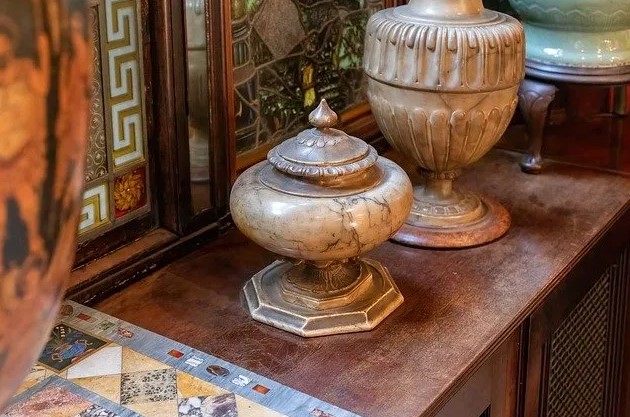
Funeral urns have been an integral part of cultural mourning rituals and memorialisation practices for centuries. Dating back to ancient civilisations, they have evolved to reflect the changing beliefs, aesthetics, and needs of people throughout history.
Eternity Pebble acknowledges this rich cultural heritage by crafting exceptional, handfinished pebble-shaped funeral urns, honouring the memory of lost loved ones with timeless elegance and artistry.
In this intriguing article, we delve into the fascinating history of funeral urns, tracing their origins and progression across various cultures and time periods. By examining the evolution of funeral urns, not only can we gain valuable insights into diverse memorialisation practices but also appreciate the enduring significance of urns in helping to preserve the memory of those who have passed.
Embark with us on a journey through time and cultures as we explore the captivating history of funeral urns and unravel their timeless importance in human history.
1. Ancient Civilisations and the Origins of Funeral Urns
The historical significance of funeral urns can be traced back to ancient civilisations, where they played a crucial role in burial and memorialisation practices. Key examples include:
– Ancient Greece: In ancient Greece, funeral urns were called “lekythoi” and were used to store oil, wine, or ashes of the deceased. These urns were intricately decorated with scenes from daily life or mythological narratives and were often buried alongside the deceased as valuable grave goods.
– Roman Empire: The Romans created cinerary urns made of various materials like marble, alabaster, and glass. These urns were typically inscribed with information about the deceased, such as their name and age, and placed inside niches or tombs.
– Han Dynasty China: Funeral urns dating back to the Han Dynasty (206 BCE – 220 CE) are considered among the most elaborate and ornate examples of burial artefacts in history. These urns were made of lacquered wood, bronze, or ceramic and were intricately decorated with auspicious symbols, scenes, and images of divinities.
2. The Middle Ages and the Rise of Christian Memorialisation
During the Middle Ages, the practice of cremation declined due to the growth of Christianity, which traditionally favours inhumation (burial) over cremation. However, funeral urns continued to hold relevance as objects of memorialisation and religious significance. Some examples include:
– Medieval European Reliquaries: Although not strictly funeral urns, reliquaries served a similar purpose by functioning as vessels to hold and protect sacred religious relics, such as bone fragments, teeth, or other bodily remains of saints. Often made of precious metals and adorned with gems, these artefacts reflect the importance of preserving human remains in a reverent manner.
– Byzantine Funerary Urns: During the rise of the Byzantine Empire, funeral urns regained prominence in burials of high-ranking officials and nobles. These urns, made of stone, terracotta or metal, were adorned with intricate carvings and inscriptions to commemorate the deceased and signify their status.
3. Funeral Urns during the Renaissance and Baroque Periods
The Renaissance and Baroque periods saw a revival of interest in the classical world, resulting in an increased appreciation of funeral urns as artistic and symbolic objects. The importance of funeral urns during these periods can be observed in the following:
– Classicism in Art and Funerary Monuments: Artists and architects of the time drew inspiration from ancient Greek and Roman art, leading to the creation of highly ornamented urns as part of monumental tombs and funerary sculpture.
– The inclusion of urns in European portraiture: The use of urns as symbols of mourning and the passage of time became a popular artistic motif during the Baroque period. Urns were often depicted in portraits alongside other allegorical symbols, such as the skull or hourglass, to remind viewers of the transience of life.
4. The Modern Era and the Resurgence of Cremation and Funeral Urns
In the 19th and 20th centuries, the practice of cremation began to regain popularity due to increasing urbanisation and the establishment of cremation societies promoting the practice as efficient, hygienic, and cost-effective. With the renewed interest in cremation came a parallel resurgence in the significance of funeral urns:
– The Arts and Crafts Movement: The late 19th and early 20th centuries saw the rise of the Arts and Crafts movement, which emphasised the value of hand-crafted, beautifully designed everyday objects, including funeral urns. These urns often featured naturalistic motifs or geometric designs, reflecting the movement’s emphasis on the decorative qualities of functional items.
– Contemporary Trends in Funeral Urns: Today, funeral urns are available in a diverse array of styles, materials, and personalisation options, catering to individual preferences and cultural practices. From nature-inspired eco friendly urns to distinctive, artistically designed pieces, the modern era has seen a significant expansion in the possibilities for honouring a loved one’s memory through the selection of a unique and meaningful funeral urn.
The history of funeral urns illustrates the enduring importance of these objects as memorials and symbols of love and respect for the deceased. By understanding the rich cultural heritage and diverse practices surrounding funeral urns across time, we are better equipped to appreciate their ongoing relevance as cherished tributes to those who have passed.
Personalised Urns: An Enduring Tribute and an Integral Part of Healing
Coping with the loss of a loved one is undeniably challenging, but finding solace in personalised funeral urns can make a significant impact on the healing process. By carefully selecting design elements, inscriptions, and materials, you can create a unique and moving tribute that honours your loved one’s life, legacy, and spirit.
Eternity Pebble invites you to explore our range of natural pebble-shaped ceramic funeral urns, where you can find beautiful and meaningful memorial solutions that will resonate not just with your personal grief but with the memory of the departed. Let us help guide you in the selection of a funeral urn that supports your journey of healing, reaffirms your emotional connections, and serves as a lasting testament to your loved one’s incredible life story. Contact us today for more information.
